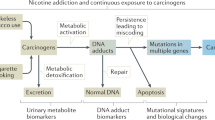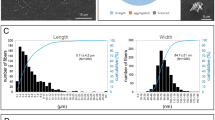Summary
This experiment has been performed to clarify the question to which extent fractions containing polycyclic aromatic hydrocarbons (PAH) or other carcinogenic compounds are responsible for the biological activity of cigarette smoke condensate. With chromatographic procedures using organic gels it was possible to separate quantitatively polar compounds from the PAH-fraction and to obtain fraction IX representing 0.4% of the whole condensate. In this fraction the PAH were enriched 250fold. Significant losses of tumorigenic effects by this fractionation method could not be observed. This PAH-containing fraction showed 50% of activity compared with the overall activity of whole smoke condensate of a reference cigarette. A so-called PAH-free fraction showed with 7% of the overall activity of the whole smoke condensate a weak carcinogenic effect. The importance of PAH for the tumorigenic effect of cigarette smoke is emphasized by these results.
Zusammenfassung
Die vorliegende Arbeit beantwortet die Frage, in welchem Maße Fraktionen mit polycyclischen aromatischen Kohlenwasserstoffen (PAH) und anderen carcinogenen Verbindungen für die biologische Aktivität von Zigarettenrauchkondensat einer Standardzigarette verantwortlich sind. Mit chromatographischen Verfahren unter Verwendung organischer Gele gelang eine weitgehende Abtrennung polarer Verbindungen von der PAH-Fraktion und eine Anreicherung der PAH um das 250fache in einer Fraktion IX, die nur 0,4% des Ausgangskondensates ausmachte. Signifikante Wirkungsverluste durch diese Fraktionierungsmethoden traten nicht ein. Im Vergleich zur tumorerzeugenden Wirkung des Gesamtkondensates einer Standardzigarette zeigte diese PAH-Fraktion noch etwa 50% der Ausgangsaktivität. Eine sog. PAH-freie Fraktion war mit 7% der Gesamtaktivität schwach carcinogen. Damit wird die Bedeutung der PAH für die tumorerzeugende Wirkung von Zigarettenrauch unterstrichen.
Similar content being viewed by others
Literatur
Bock,F.G., Swain,A.P., Stedman,R.L.: Composition studies on tobacco. XLIV. Tumor-promoting activity of subfractions of the weak acid fraction of cigarette smoke condensate. J. nat. Cancer Inst. 47, 429–436 (1971)
Bock,F.G., Swain,A.P., Stedman,R.L.: Carcinogenesis assay of subfractions of cigarette smoke condensate prepared by solvent-solvent separation of the neutral fraction. J. nat. Cancer Inst. 49, 477–483 (1972)
Day,T.D.: Carcinogenic action of cigarette smoke condensate on mouse skin. Brit. J. Cancer 21, 56–81 (1967)
Dontenwill,W., Elmenhorst,H., Harke,H.-P., Reckzeh,G., Weber,K.-H., Misfeld,J., Timm,J.: Experimentelle Untersuchungen über die tumorerzeugende Wirkung von Zigarettenrauch-Kondensaten an der Mäusehaut. I.–III. Mitt. Z. Krebsforsch. 73, 265–314 (1970)
Dontenwill,W., Chevalier,H.-J., Harke,H.-P., Klimisch,H.-J., Lafrenz,U., Reckzeh,G., Fleischmann,B., Keller,W.: Experimentelle Untersuchungen über die tumorerzeugende Wirkung von Zigarettenrauch-Kondensaten an der Mäusehaut. IV. Mitt. Z. Krebsforsch. 78, 236–64 (1972)
Dontenwill,W., Chevalier,H.-J., Harke,H.-P., Klimisch,H.-J., Rechzeh,G., Fleischmann,B., Keller, W.: Experimentelle Untersuchungen über die tumorerzeugunede Wirkung von Zigarettenrauch-Kondensaten an der Mäusehaut. V. Mitt. Z. Krebsforsch, im Druck (1976)
Duuren van,B.L., Katz,C., Goldschmidt,M.B.: Brief Communication: Cocarcinogenic agents in tobacco carcinogenesis. J. nat. Cancer Inst. 51, 703–705 (1973)
Elmenhorst,H., Dontenwill,W.: Nachweis cancerogener Kohlenwasserstoffe im Rauch beim Grillen über Holzkohlenfeuer. Z. Krebsforsch. 70, 157–160 (1967)
Elmenhorst,H., Grimmer,G.: Polycyclische Kohlenwasserstoffe aus Zigarettenrauchkondensat. Eine Methode zur Fraktionierung großer Mengen für Tierversuche. Z. Krebsforsch. 71, 66–73 (1968)
Grimmer,G.: Persönliche Mitteilungen (1971, 1973)
Hoffmann,D., Wynder,E.L.: A study of tobacco carcinogenesis. XI. Tumor initiators, tumor accelerators, and tumor promoting activity of condensate fractions. Cancer 27, 848–864 (1971)
Hoffmann,D., Schmeltz,I., Hecht,S.S., Wynder,E.L.: On the identification of carcinogens, tumor promoters and cocarcinogens in tobacco smoke. 3rd World Conference on Smoking and Health. 2.–5.6. 75 in New York
Horton,A.W., Christian,G.M.: Cocarcinogenic versus incomplete carcinogenic activity among aromatic hydrocarbons. Contrast Between Chrysene and Benzo(b)triphenylene. J. nat. Cancer Inst. 53, 1017–1020 (1974)
Klimisch,H.-J.: Vergleichende chemisch-analytische Untersuchungen an Kondensaten modifizierter Cigaretten. Diskussion einer Korrelation zur biologischen Wirksamkeit. Z. Lebensmitt.-Untersuch. 150, 93–99 (1972)
Klimisch,H.-J., Stadier,L.: Gelverteilungschromatographisches Verfahren zur präparativen Abtrennung polarer Substanzen von polyzyklischen aromatischen Kohlenwasserstoffen. Fraktionierung von Cigarettenrauchkondensat. J. Chromatog. 67, 175–178 (1972)
Klimisch,H.-J.: Anreicherungsund Trennverfahren zur Analyse polyzyklischer aromatischer Kohlenwasserstoffe. Z. Anal. Chem. 264, 275–278 (1973)
Lazar,Ph., Chouroulinkov,I., Izard,C., Moree-Testa,P., Hemon,D.: Bioassays of carcinogenicity after fractionation of cigarette smoke condensate. Biomed. 20, 214–222 (1974)
Lijinsky,W., Garcia,H., Saffiotti,U.: Structure-activity relationships among some polynuclear hydrocarbons and their hydrogenated derivatives. J. nat. Cancer Inst. 44, 641–649 (1970)
Lijinsky,W., Garcia,H.: Skin carcinogenesis tests of hydrogenated derivatives of anthanthrene and other polynuclear hydrocarbons. Z. Krebsforsch. 77, 226–230 (1972)
Misfeld,J., Timm,J.: Mathematische Aspekte der Planung und Auswertung von Experimenten zur Krebsforschung. In: Zur Methodik der Untersuchung von Rauchkondensaten im Tierversuch. Wissenschaftl. Forschungsstelle im Verband der Cigarettenindustrie, Hamburg 1969, 85–119
Neurath,G., Ehmke,H., Horstmann,H.: Einfluß des Feuchtigkeitsgehaltes von Cigaretten auf die Zusammensetzung des Rauches. III. Beitr. Tabakforsch. 2, 361–369 (1964)
Oelert,H.H.: Atypische Gel-Chromatographie im System Sephadex-Isopropanol. Z. Anal. Chem. 244, 91–101 (1969)
Schmähl,D., Schmidt,K.G.: Conception and methods of experimental studies in Germany to estimate the carcinogenic burden by air pollution in man. In: Karbe,E., Park,J.F. (Eds.): Experimental Lung Cancer, S. 139. Berlin-Heidelberg-New York: Springer 1974
Whitehead,J.K., Rothwell,K.: The mouse skin carcinogenicity of cigarette smoke condensate: fractioned by solvent partition methods. Brit. J. Cancer 23, 840–857 (1969)
Author information
Authors and Affiliations
Rights and permissions
About this article
Cite this article
Dontenwill, W., Chevalier, H.J., Harke, H.P. et al. Experimentelle Untersuchungen über die tumorerzeugende Wirkung von Zigarettenrauch-Kondensaten an der Mäusehaut. Z. Krebsforsch. 85, 155–167 (1976). https://doi.org/10.1007/BF00304948
Received:
Accepted:
Issue Date:
DOI: https://doi.org/10.1007/BF00304948




